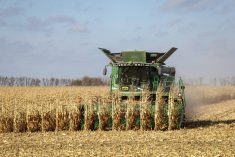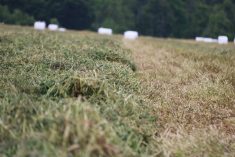The early bird gets the worm, and the best weed control, at least based on conventional wisdom that the best time to spray is when wind in lightest in the morning.
But the results of trials by Farming Smarter, southern Alberta’s farm research group, indicate that spray operators don’t have to set their alarms quite so early, or stay up so late.
“We figured spraying at night, at cooler temperatures when the herbicides would remain in the leaves longer, would probably be the best,” says Ken Coles, Farming Smarter manager. “Some chemicals photo-degrade — they’re broken down in sunshine, so we expected they might be more effective at night,” Coles said.
Read Also

Manitoba Ag Days 2026 coming up fast
Canada’s largest indoor farm show, Manitoba Ag Days, returns to Brandon’s Keystone Centre Jan. 20-22, 2026. Here’s what to expect this year.
“Also, plants close their stomata at high daytime temperatures — you’d think that would reduce herbicide effectiveness,” he said. “These days, with autosteer and GPS guidance, it’s not a big deal to work in the dark and it’s something lots of people do. But, with the sort of impact we’ve seen, maybe we need to reconsider.”
The researchers applied pre-seeding burn-down chemicals at three times — midnight to 1 a.m., 4 to 5 a.m., or noon to 1 p.m., all on a single day. They didn’t expect to see big differences due to timing — after all, they reasoned, products are registered with high enough label rates to perform well under all conditions. They used three-quarter rates of burn-down chemicals when weeds were small, so they’d see differences. They used full rates when weeds were bigger and harder to kill.
For pre-seed products, they applied glyphosate alone, and the non-glyphosate herbicide components of Prepass, Clean Start and Heat, so they would avoid interactions of the active ingredients. They also tested a range of widely used in-crop herbicides in Roundup Ready canola, Liberty Link canola, peas and wheat.
Consistent results
No matter what herbicide they used, the rate and whether it was a pre-seed burn-off or in-crop, the results were completely consistent. Weed control was best when the herbicide was sprayed between noon and 1 p.m. The worst time to spray, for all herbicides, pre-seeding or in-crop, was between 4 and 5 a.m.
“I’m astounded,” says Coles. “It’s not what we expected at all. We thought a few things might be more effective during the day — it’s not recommended to spray Liberty at night, but I really didn’t think the impact would be so strong. And, I really thought that in the middle of the day, when the spray dries almost immediately, the chemical wouldn’t get into the plant as effectively.”
Coles said visual ratings showed as much as 80 per cent greater efficacy for Liberty sprayed at noon compared to spraying at 4 or 5 a.m. “It wasn’t what I expected at all.”
On the other hand, especially in spring, daytime temperatures mean that plants are growing rapidly, their metabolic rate is high, so the herbicide’s active ingredient can move rapidly through the plant and work well on its target site. Even more surprising was that crop tolerance was better at noon. And, crop damage appeared to be worse when herbicides were sprayed at dawn. Once again, the results were totally consistent across all the herbicides.
Temperature effect
Coles suspects cool temperatures at night and especially in the early morning may have affected herbicide performance.
“We had quite wide temperature fluctuations, so that may be a big part of the differences in herbicide efficacy,” he said. “We’ll be studying that over the winter when we can look at the statistics and everything. We’ll also compare our results with those of Lakeland (Applied Research Association) at Bonnyville and SARDA (Smoky Applied Research and Demonstration Association) at Falher.”
Over the winter, the research groups will compare their results from their different locations where temperatures likely varied quite a bit. They’ll also look at biomass measurements and yields. Coles is hoping to add fungicides to next year’s testing for the effect of time of day on the effectiveness of pesticides.
Coles isn’t ignoring the reality of spraying — no matter how big your sprayer — there’s always too many acres to cover and the window of calm air or light breezes is too narrow. “We spray early in the morning because in southern Alberta that’s often the only time the wind calms enough to spray. But today, with new nozzle technology, we can spray safely in much higher winds than we could 10 years ago,” he said.
“Maybe it’s time to rethink the ideal time to spray and when to take a break from spraying and when to go with full rates rather than cutting back. Maybe it’s better to go out for a few hours after supper than to be out at the crack of dawn.”














